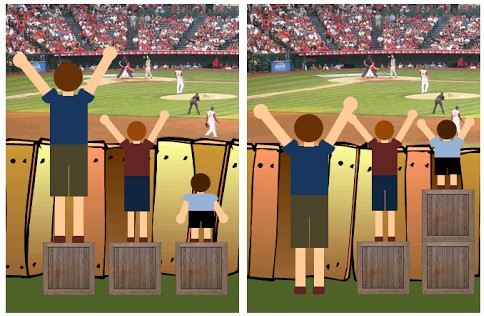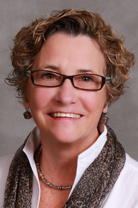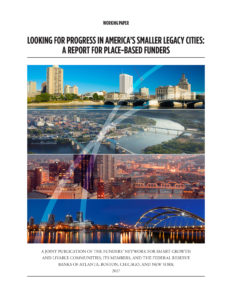As part of our ongoing work exploring the lessons and recommendations offered in Looking for Progress in America’s Smaller Legacy Cities: A Report for Place-based Funders, we asked some of the participants in the study: How has revitalization proceeded in your community, and how might your foundation and local partners ensure that economic growth and economic opportunity develop in a coordinated fashion? Carolyn Saxton, president & CEO of the Legacy Foundation, shares her thoughts: During the past year the Funders’ Network’s Federal Reserve-Philanthropy Initiative conducted site visits to several industrial cities: Rochester, New York; Grand Rapids, Mich.; Cedar Rapids, Iowa; and Chattanooga, Tenn. The purpose of these visits was to explore four small cities that appeared to have experienced some measure of revitalization in the post Great Recession environment. I was one of several community foundation leaders invited to participate in these exploratory journeys and I went to each (with the exception of Chattanooga). These trips were particularly important given Legacy Foundation’s work in four communities in Lake County, Indiana: Gary, East Chicago, Hammond and Whiting. Once a thriving center of steel production and other forms of manufacturing, Lake County has seen a loss of manufacturing beginning in the 1960s. This has contributed to the related problems of economic distress, population loss, property abandonment, and loss of municipal tax base. The effects of this decline persist into the present, manifesting in high levels of joblessness, low-performing schools, and neighborhood deterioration. Our discussions following the four site visits evolved into debating the question of where these cities were on the arc of economic growth and economic opportunity. We generally agreed that place-based funders are central not only to advancing economic opportunity among disenfranchised populations, but to connecting opportunity-oriented programs to economic development efforts. Two current programs in Lake County reflect the Legacy Foundation’s commitment to shaping the arc of economic opportunity over the long term. Three years ago Lake County was one of six Indiana counties selected by the state for a multi-year pilot “On My Way Pre-K”, an initiative for economically vulnerable 4-year-olds to have an early childhood pre-kindergarten educational experience. Studies show: • 90% of a child’s brain development occurs before the age of 5. • Children in poverty face academic and social opportunity gaps including a lack of early exposure to language, reading and math. • Children from low income families typically start school a year to a year and a half behind their peers. The average fourth-grader growing up in poverty is already three grade levels behind — and only half of every fourth-grade class will graduate from high school. • This achievement gap negatively impacts the local workforce and economic development. • Numerous research studies have demonstrated that that this gap is lessened by providing high-quality early learning environments for children who live in disadvantaged environments. Parents from Gary, East Chicago, Whiting, Hammond and other Lake County communities select the pre-school where their child will attend from a list of qualified providers. Supplemental programs are designed to involve them in their child’s learning from kindergarten through third grade. Legacy Foundation and other funders raised the necessary funds to qualify for a state match which together totaled $3.6 million for hundreds of Lake County children and their families. This project has a long-term waiting period to determine if the children will succeed academically, but it provides the equitable opportunity that these children would not have had otherwise. For sustainable change to take root it is important to have those most affected to be included as partners in order to work on a resolution and address inequitable opportunities. As place-based funders, our role is to ensure that those who are experiencing the oppression are involved in developing solutions. This thought is the lens for Legacy Foundation’s Neighborhood Spotlight initiative. Neighborhood Spotlight engages community residents through a collective impact process to develop and act on plans for transforming their own neighborhoods. What is collective impact? It is people sharing ideas to make their neighborhood a better place to live and work. Selected neighborhoods receive customized year-long mentoring to engage residents, business owners, and school and government personnel to gather opinions on neighborhood concerns which need improvement, such as jobs, education, and transportation. Work groups around each identified area are then convened to develop improvement goals. Ultimately the goals from each work group are brought to the larger group and an overall plan for the neighborhood is developed. Gary-Emerson neighborhood was chosen last year to take part in Neighborhood Spotlight, while the Gary-Miller neighborhood — selected three years ago — has already been executing projects. One of their action steps was to create an environment to promote and encourage entrepreneurial growth. With Legacy’s support, residents can now take advantage of financial literacy programs and small business development workshops. They have also established a small business incubator in their neighborhood. We have recently received a grant from the Regional Development Authority to support projects from their transportation plan. So what did I take away from our visits to the smaller legacy cities we studied as part of the Federal Reserve-Philanthropy Initiative? Thinking retrospectively, I would argue that it is more than just economic opportunity that we as funders need to provide. Our role is to create a level playing field for those who are disenfranchised. Our role is to ensure that we are providing equitable opportunity, which takes the discussion much deeper. How do we define equitable opportunity? Here’s an illustration you’re probably already familiar with:  Three children of different heights go to a ball game. They only have standing room which is at an ivy-covered fence and none can see over the top. Each child is given a box to stand on to help with their viewing. The tallest child is in fine shape and is able to see every play. The second child can see over the fence if he stands on his toes. The third child is still about a foot shorter than the top of the fence. He only gets a view of the ivy he faces. Equal opportunity? Yes. Each child was at the game, had a place at the fence and was given a box to stand on. Equitable? No. Each child needed a different number of boxes to see over the fence and watch the game. If we only look at economic growth and economic opportunity, we are missing that key factor of equity. Jobs might be available which in turn will build economic growth. But if we don’t make it possible for everyone to be prepared equitably to compete for those jobs, we will always have those left out of the recovery continuum. And we’ll always have children unable to see over that fence. Neighborhood Spotlight and On My Way Pre-K are steps forward in providing equitable opportunity. Neither can be easily evaluated in one, three, or even five years. But as we place-based funders make decisions, we must ensure that our lens is focused on creating an equitable environment for all.
Three children of different heights go to a ball game. They only have standing room which is at an ivy-covered fence and none can see over the top. Each child is given a box to stand on to help with their viewing. The tallest child is in fine shape and is able to see every play. The second child can see over the fence if he stands on his toes. The third child is still about a foot shorter than the top of the fence. He only gets a view of the ivy he faces. Equal opportunity? Yes. Each child was at the game, had a place at the fence and was given a box to stand on. Equitable? No. Each child needed a different number of boxes to see over the fence and watch the game. If we only look at economic growth and economic opportunity, we are missing that key factor of equity. Jobs might be available which in turn will build economic growth. But if we don’t make it possible for everyone to be prepared equitably to compete for those jobs, we will always have those left out of the recovery continuum. And we’ll always have children unable to see over that fence. Neighborhood Spotlight and On My Way Pre-K are steps forward in providing equitable opportunity. Neither can be easily evaluated in one, three, or even five years. But as we place-based funders make decisions, we must ensure that our lens is focused on creating an equitable environment for all.  About the author: Carolyn Saxton is president & CEO of the Legacy Foundation
About the author: Carolyn Saxton is president & CEO of the Legacy Foundation

Looking for Progress in America’s Smaller Legacy Cities: A Report for Place-based Funders As part of The Funders’ Network-Federal Reserve Philanthropy Initiative, the Federal Reserve Banks of Atlanta, Boston, Chicago, and New York recently released, in partnership with The Funders’ Network, a whitepaper presenting findings from a four-city study tour of older, legacy cities. This blog is the second in an occasional series stemming from that report. The full report can be downloaded here.
